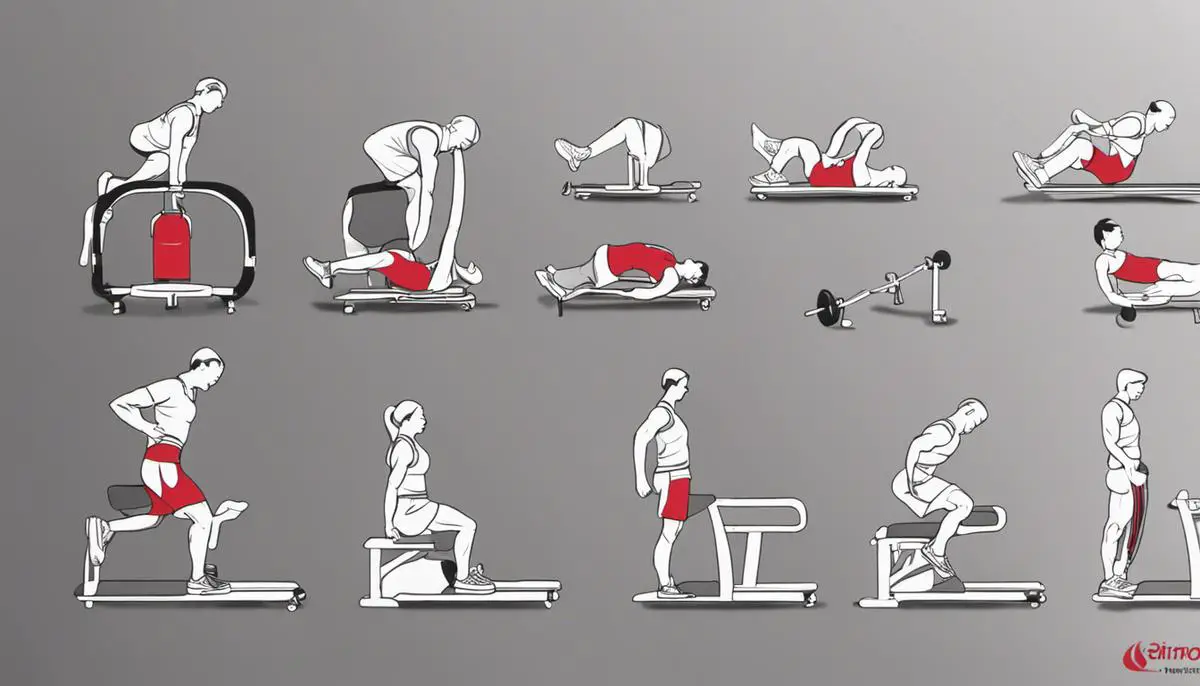Millions of people every day suffer from lower back pain and discomfort, which can significantly affect their quality of life. Understanding the anatomy of the lower back and the principles of gentle, therapeutic exercises can go a long way in helping manage and prevent this pain. This discussion will help familiarize you with key muscles and vertebrae involved in back movement, the fundamentals of gentle exercises, and specific lower back exercise techniques. Additionally, we will cover ways you can incorporate these exercises into your daily routine to promote consistent pain management and prevention.
Understanding Lower Back Anatomy
Understanding Lower Back Anatomy
The lower back, also known as the lumbar region, is a complex system of interconnected and overlapping elements including vertebrae, muscles, tendons, ligaments, nerves, and blood vessels.
Vertebrae in Lower Back
The lower back primarily consists of five lumbar vertebrae, named as L1 through L5. These vertebrae are the largest and strongest in the spine, allowing them to support the majority of the body’s weight. They are also the most likely part of the back to be affected by pain or injury because they bear so much stress. Between each vertebra, there are intervertebral discs, which act as shock absorbers and permit flexibility in the spine.
Key Muscles and their Function
The key muscles related to lower back stability and movement involve the extensor, flexor, and oblique muscles. Extensor muscles, including the erector spinae and the gluteal muscles, are attached to the back of the spine and enable you to stand straight and lift heavy items. Flexor muscles, located in the front and include abdominal muscles, are used for bending and flexing movements. Oblique muscles, attached to the sides, help with rotational movements.
These muscles work together to provide support, stability, and movement for the lower back. When these muscles become weak from lack of exercise or overuse, the risk of injury to the lower back increases.
The Role of Ligaments and Nerves
Ligaments are fibrous bands that hold the vertebrae together, stabilize the spine, and protect the discs. Nerves in the lower back control the muscles in the pelvis, legs, and feet. The major nerve in the lower back, known as the sciatic nerve, is the longest nerve in the body. It runs from the lower spine down to the feet.
Understanding this anatomy can help you determine which exercises will best strengthen the muscles, ligaments, and tendons that support your lower back. Exercises that strengthen and stretch these components can help alleviate and prevent lower back pain.

Fundamentals of Gentle Exercises
Understanding Gentle Exercises for Lower Back
Gentle exercises for the lower back are typically movements that engage the muscles in your back, abdomen, and glutes—these are the groups of muscles that support your spine. Gentle exercises work to promote strength, flexibility, and overall wellbeing without causing strain or injury. They help to align the natural curve of your spine, maintain correct posture, and relieve or prevent back pain.
Types of Gentle Exercises for Lower Back
Different types of gentle exercises for lower back include yoga stretches, Pilates movements, and low-impact aerobic exercises. These activities focus on slow, steady movements and maintaining balance, which limit strain on your back while enhancing your strength and flexibility.
Performing Gentle Exercises: Yoga Stretches
Yoga exercises often include positions that stretch and strengthen muscles without much vigorous movement. The cat-camel stretch, for instance, is a good gentle exercise for the lower back. Start by getting on your hands and knees, ensuring your hands are directly below your shoulders and knees are below your hips. Then, slowly arch your back upwards like a cat, hold for five seconds, then dip your back down like a camel, and hold for another five seconds.
Performing Gentle Exercises: Pilates Movements
Pilates are movements that concentrate on core strength, balance, and flexibility. Pilates exercises, such as the swimming move, effectively work the lower back. Lay on your stomach, extend your arms and legs, and alternately lift your right arm with your left leg, and then your left arm with your right leg. The key here is slow, steady movements to activate back and abdominal muscles.
Performing Gentle Exercises: Low-Impact Aerobics
Low-impact aerobics, such as walking or water aerobics, can also be a gentle way to exercise the lower back. These activities get your heart pumping and your muscles working without jarring your for lower back.
Exercise Duration and Frequency
For overall wellness and maintaining a healthy lower back, aim to engage in these gentle exercises most days of the week. Start with a session that lasts 10 to 15 minutes, then gradually work your way up to 30-minute sessions as your strength and flexibility increase. Be sure to listen to your body in order not to overdo it.
Safety Considerations
Gentle doesn’t mean risk-free. Always remember to perform these exercises on a stable surface to prevent slipping. Gradual movement will help to prevent sudden strain or stress on your lower back. If any exercise causes pain, stop doing it. If you have chronic back pain or a recent injury, consult with your doctor or a physical therapist before starting any exercise routine. They can help design a safe and effective workout plan to meet your needs and prevent further injury.

Lower Back Exercise Techniques
Pelvic Tilt Exercises for Lower Back
Pelvic tilt exercises not only strengthen your lower back, but also your abdominal muscles. Start by lying on your back on a flat surface with your knees bent and your feet flat on the floor. In this position, press your lower back into the floor by tightening your abdominal muscles and tilting your pelvis. Try to hold this position for 5 to 10 seconds. Start with 10 repetitions and gradually increase to 20 repetitions as your strength improves. Ideally, try to repeat this exercise twice daily. Always perform these exercises in a controlled manner and avoid sudden movements to ensure safety.
Knee-to-Chest Stretches
This stretch aids in relieving tension in your lower back. Lay on your back with both legs extended. Bring one knee, then the other, to your chest, using your hands to gently pull the knee closer. Hold it there for 15-20 seconds. Do this for each leg individually, and then with both legs together. Start with three repetitions for each leg and gradually increase over time. You should aim to do this exercise every day, ideally once in the morning and once at night. Always remember to breathe comfortably during this exercise and avoid holding your breath.
Bird-Dog Poses for Lower Back
The bird-dog pose helps in improving balance, stability, and coordination, while also strengthening the lower back. To begin, get on all fours with your hands directly under your shoulders and your knees directly under your hips. Slowly extend your left leg behind you while reaching your right arm in front of you. Be sure to keep your spine aligned and your head looking downwards. Hold for five seconds, then slowly return to the starting position and repeat with the opposite arm and leg. Initially, aim for five repetitions on each side, slowly increasing to 15 repetitions over time. Perform this exercise every other day. Ensure you’re not stretching beyond your comfort zone, to avoid strain.
Precautions to Avoid Injury
Safety is crucial during these exercises. Always start with warm-up stretches to prep your muscles. If you feel any sharp pain during the exercises, stop immediately. It’s important to maintain correct posture and alignment throughout the exercises to avoid unnecessary strain. When performing these exercises, focus on quality rather than quantity. Consistency, control, and precision should be the goal. Remember to consult your healthcare professional before starting any new exercise regimen if you have an existing back condition.

Incorporating Exercises into Daily Routine
Establishing a Daily Routine
Model your exercise routine by the pattern of your daily activities. Try incorporating a few gentle exercises for your lower back to start your day. Right after waking up can be an excellent time for gentle stretches, such as lying flat on your back, pulling one knee at a time to your chest, or a simple supine twist. These simple movements can help kick start your day by increasing blood flow to your lower back and reducing stiffness.
Using Break Time for Movement
Office workers are especially at-risk for back pain due to prolonged sitting. Use a standing desk if available, and take regular breaks every 30 minutes to one hour to move around. A quick stretch or walk can ease tension in your lower back. Try incorporating exercises like seated leg raises, seated spinal twists or a few minutes of standing back extensions during your breaks.
Post-workout Lower Back Care
If you engage in workouts or strenuous activities, follow them with gentle lower back exercises to avoid strains. The Child’s pose and Cat-Camel stretches are excellent for soothing lower back muscles subjected to tension. Remember, cool down exercises are not just for athletes but for anyone who engages in physical activity.
Be Consistent
Consistency in performing these exercises can be a vital part of pain management and prevention. A regular routine of doing gentle lower back exercises can enhance flexibility, strength, and overall back health. Try committing to a schedule and stick to it, as having a regular routine can make it easier to maintain.
Mindfulness Matters
Mind-body exercises like yoga and Pilates can also help manage and prevent lower back pain. They improve your body’s awareness and help maintain proper posture and movements, reducing the chances of injury and strain. Integrate a session of yoga or Pilates into your weekly exercise routine for optimal results.
In Diversity There’s Benefit
Don’t limit yourself to a single exercise. Rotate a handful of lower back exercises throughout your week to provide your back a comprehensive workout that hits different muscles. The key is not to see these exercises as an isolated part of your day but as intrinsic parts of your daily actions—just like brushing your teeth or having breakfast.
Exercise and Professional Advice
While these tips can provide a roadmap to incorporate gentle exercises into your daily routine, it is recommended to consult with a healthcare professional or physical therapist to ensure these exercises are suitable for your unique condition.

With a clear understanding of your lower back anatomy and the benefits of gentle exercise, you can work to reduce lower back pain and improve your quality of life. Techniques such as pelvic tilts, knee-to-chest stretches, and bird-dog poses, when done correctly and regularly, can strengthen and stabilize your lower back without causing strain or injury. Incorporating these activities into your daily routine doesn’t have to be daunting or time-consuming. By implementing a few changes, you can engage in preventative measures against back pain and embrace an overall healthier lifestyle. You have the power to influence your wellbeing – use it wisely for a more flexible and pain-free future.
